Research on Gas Channeling Identification Method for Gas Injection Development in High-Pressure Heterogeneous Reservoir
Abstract
:1. Introduction
2. Materials and Methods
2.1. Reservoir Profile
2.2. Numerical Model Establishment and PVT Fitting of Crude Oil
2.3. Gas Channeling Discrimination Method Research
3. Results
3.1. Determination of Gas Channeling Identification Parameters
3.2. Determination of Gas Channeling Identification Parameter Values under Different Formation Pressures
3.3. Application and Verification of Gas Channeling Identification Method
4. Conclusions
- (1)
- When the produced fluid is in different phase zones in the formation, it exhibits different properties. The injected gas is dry gas with high C1 content. From the prediction curve, the gas-oil ratio and C1 content are the most sensitive to the produced fluid. Considering the convenience of field parameter selection, the gas-oil ratio and C1 content of produced gas were selected as the field characterization parameters for gas channeling discrimination.
- (2)
- According to the variation characteristics of output parameters under different pressure conditions, the gas channeling judgment standards under different pressures were established from several parameters, such as oil production, gas-oil ratio, and C1 content of produced gas.
- (3)
- The gas channeling discrimination method proposed in this paper was based on oil production, gas-oil ratio, and C1 content of produced gas to judge gas channeling in production wells on site, and the results of gas tracer detection were compared to prove its accuracy and reliability. The method has low cost and simple operation.
Author Contributions
Funding
Institutional Review Board Statement
Informed Consent Statement
Data Availability Statement
Acknowledgments
Conflicts of Interest
References
- Zhao, X.; Shi, L.; Wang, W.; Bai, Y.; Tian, F. Study on gas channeling law of CO2 flooding in heterogeneous ultra-low permeability reservoir. J. Southwest Pet. Univ. (Sci. Technol. Ed.) 2017, 39, 131–139. [Google Scholar]
- Wu, J. Study on Gas Channeling Law and Flow Mechanism of Fractured-Vuggy Carbonate Reservoir; China University of Petroleum: Beijing, China, 2016. [Google Scholar]
- Li, J.; Gao, B.; Gong, N.; Xie, Z.; Chen, Y.; Han, Y. A new evaluation method of gas channeling resistance based on fuzzy mathematics and its application. Drill. Fluid Complet. Fluid. 2017, 34, 69–74. [Google Scholar]
- Zhang, Y.; Li, X.; Sun, Z.; Li, Z.; Liu, W.; Zhang, Y. Quantitative evaluation method and application of gas channeling in gas injection development of condensate gas reservoir. Oil Drill. Prod. Technol. 2017, 39, 667–672. [Google Scholar]
- Peng, S. Study on gas channeling law of CO2 flooding in ultra-low permeability reservoir of Zhenglizhuang Oilfield, Shengli. J. Oil Gas Technol. 2013, 35, 147–169. [Google Scholar]
- Li, C. Influencing factors and rules of carbon dioxide flooding gas channeling in ultra-low permeability reservoirs. Spec. Oil Gas Reserv. 2018, 25, 82–86. [Google Scholar]
- Gao, Y.; Zhao, M.; Wang, J.; Zong, C. Production characteristics and gas channing law of CO2 immiscible flooding in ultra-low permeability reservoirs. Pet. Explor. Dev. 2014, 41, 79–85. [Google Scholar] [CrossRef]
- Wei, Q.; Hou, J.; Hao, H.; Song, Z. Study on gas channeling law of CO2 drive in ultra-low permeability reservoir. Pet. Sci. Bull. 2019, 4, 145–153. [Google Scholar]
- Li, C.; Han, H. Identification of CO2 gas channeling channel in the early stage of gas injection by grey fuzzy comprehensive evaluation method. Pet. Geol. Oilfield Dev. Daqing 2018, 37, 116–120. [Google Scholar]
- Li, J. Study on gas channeling characteristics and influencing factors of reservoir developed by CO2 injection. J. Oil Gas Technol. 2012, 34, 153–169. [Google Scholar]
- Saifullin, E.; Zhanbossynova, S.; Zharkov, D.; Varfolomeev, M.A.; Shanbosinova, S.K.; Zharkov, D.A.; Nazarychev, S.A.; Malakhov, A.O.; Sagirov, R.N. Laboratory Studies for Design of a Foam Pilot for Reducing Gas Channeling from Gas Cap in Production Well in Messoyakhskoye Field. SPE Reserv. Eval. Eng. 2022, 25, 472–485. [Google Scholar] [CrossRef]
- Si, Y.; Zhao, J.; Liang, F. Establishment and application of gas channeling identification method in Buried hill reservoir. J. Shaanxi Univ. Sci. Technol. 2020, 38, 94–101. [Google Scholar]
- Liu, D.; Zhang, J.; Wang, Y.; Yan, Z. Distinguishing method and application of gas channeling in condensate gas reservoirs. Nat. Gas Explor. Dev. 2008, 31, 27–83. [Google Scholar]
- Zhu, Y.; Li, B.; Song, W.; Tang, M.; Zhang, F.-E. Discussion on the method of distinguishing gas channeling in condensate gas reservoirs by using charts. Pet. Geol. Recovery Effic. 2004, 6, 53–85. [Google Scholar]
- Wei, Y.; Li, Z.; Wang, X.; Cui, T.; Ding, G.; Mou, W.; Kang, J. Judgment, adjustment and effect of gas injection front breakthrough in Kekeya condensate gas reservoir. Nat. Gas Ind. 2006, 6, 97–99. [Google Scholar]
- Pan, X. Numerical Simulation of Nitrogen Injection Foam for Controlling Water Channeling Technology; Northeast Petroleum University: Daqing, China, 2011. [Google Scholar]
- Wang, B.; Zhu, Y. Gas cap channeling in a gas cap field. Nat. Gas Ind. 2000, 3, 79–84. [Google Scholar]
- Schulumberger. PVTI and ECLIPSE 300; Schulumberger: Beijing, China, 2005. [Google Scholar]
- Yuan, H.; Johns, R.T.; Egwuenu, A.M.; Dindoruk, B. Improved MMP Correlations for CO2 Floods Using Analytical Gasflooding Theory. SPE Reserv. Eval. Eng. 2005, 8, 418–425. [Google Scholar] [CrossRef]
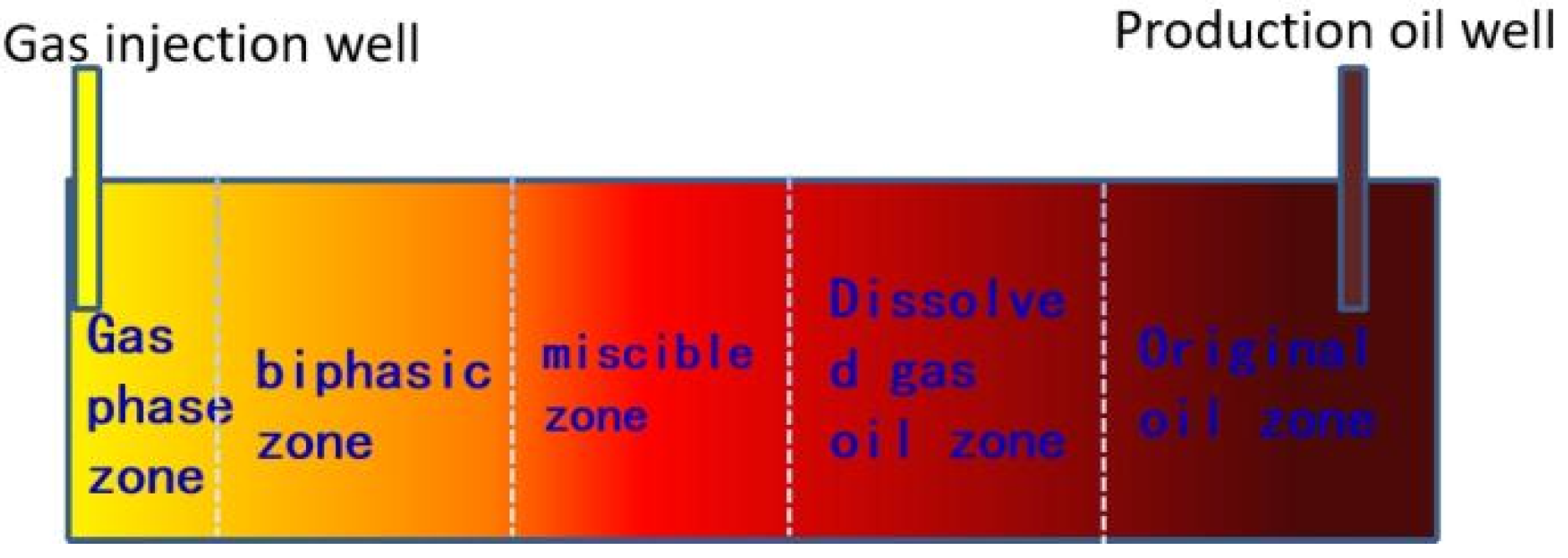
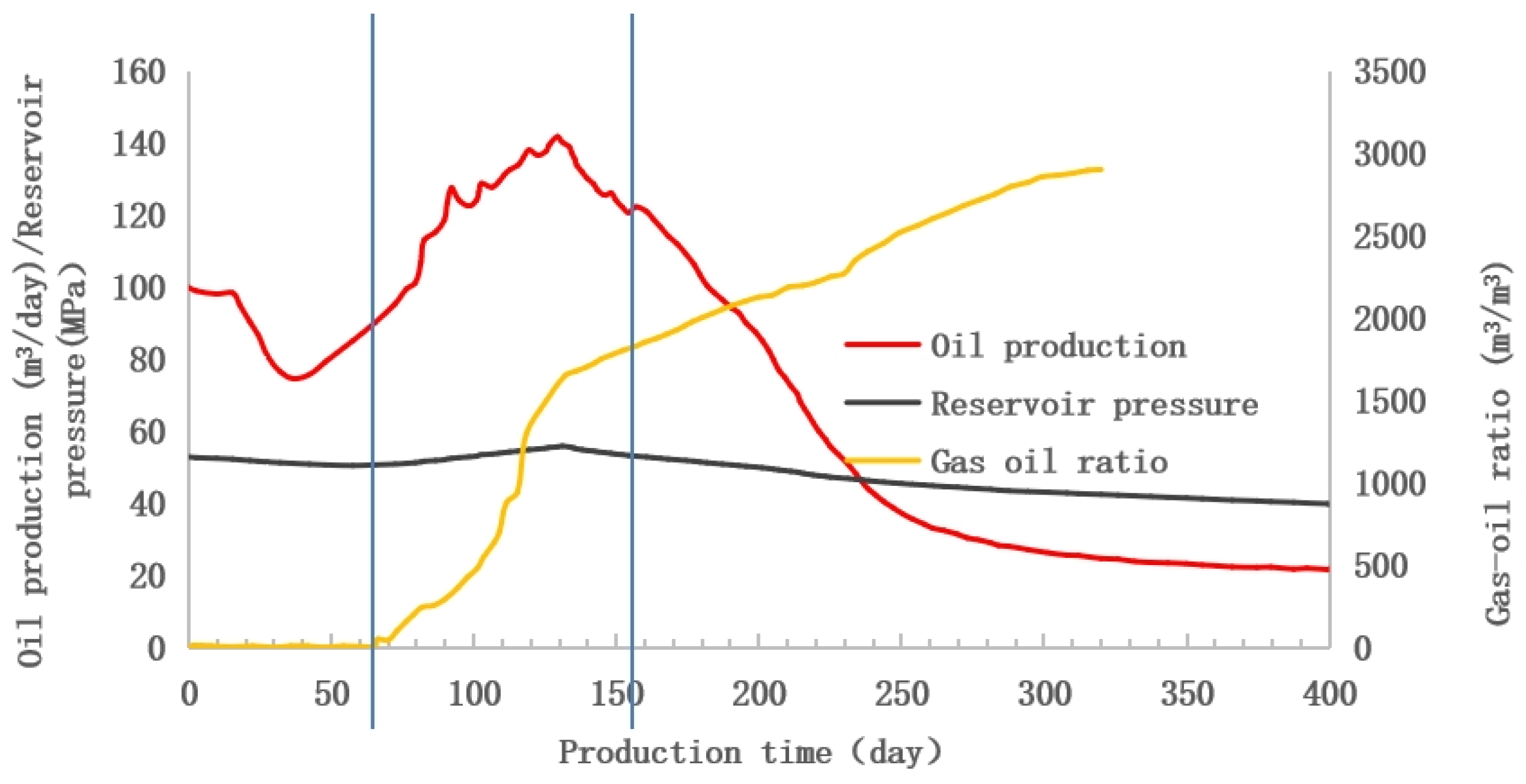


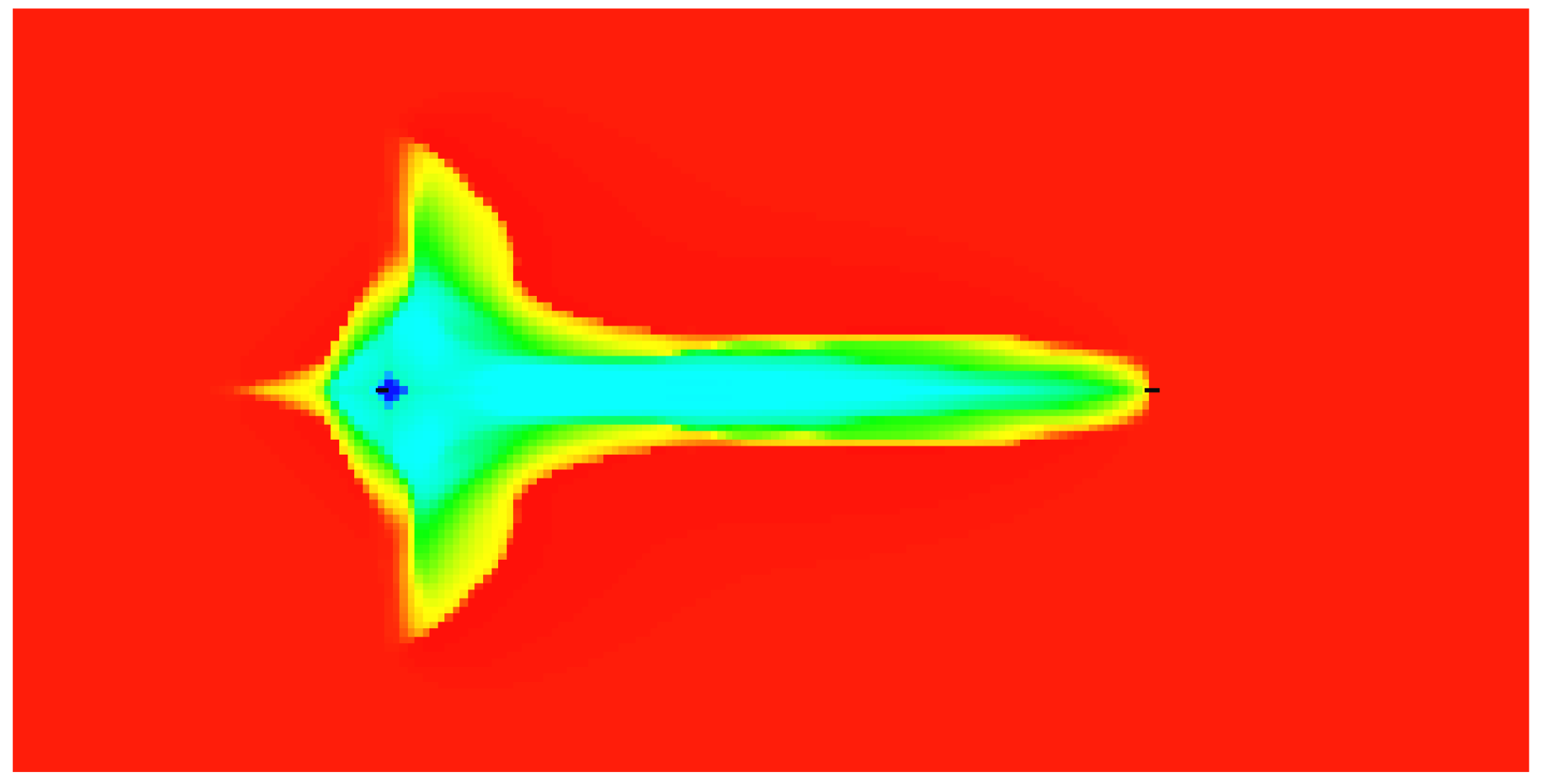
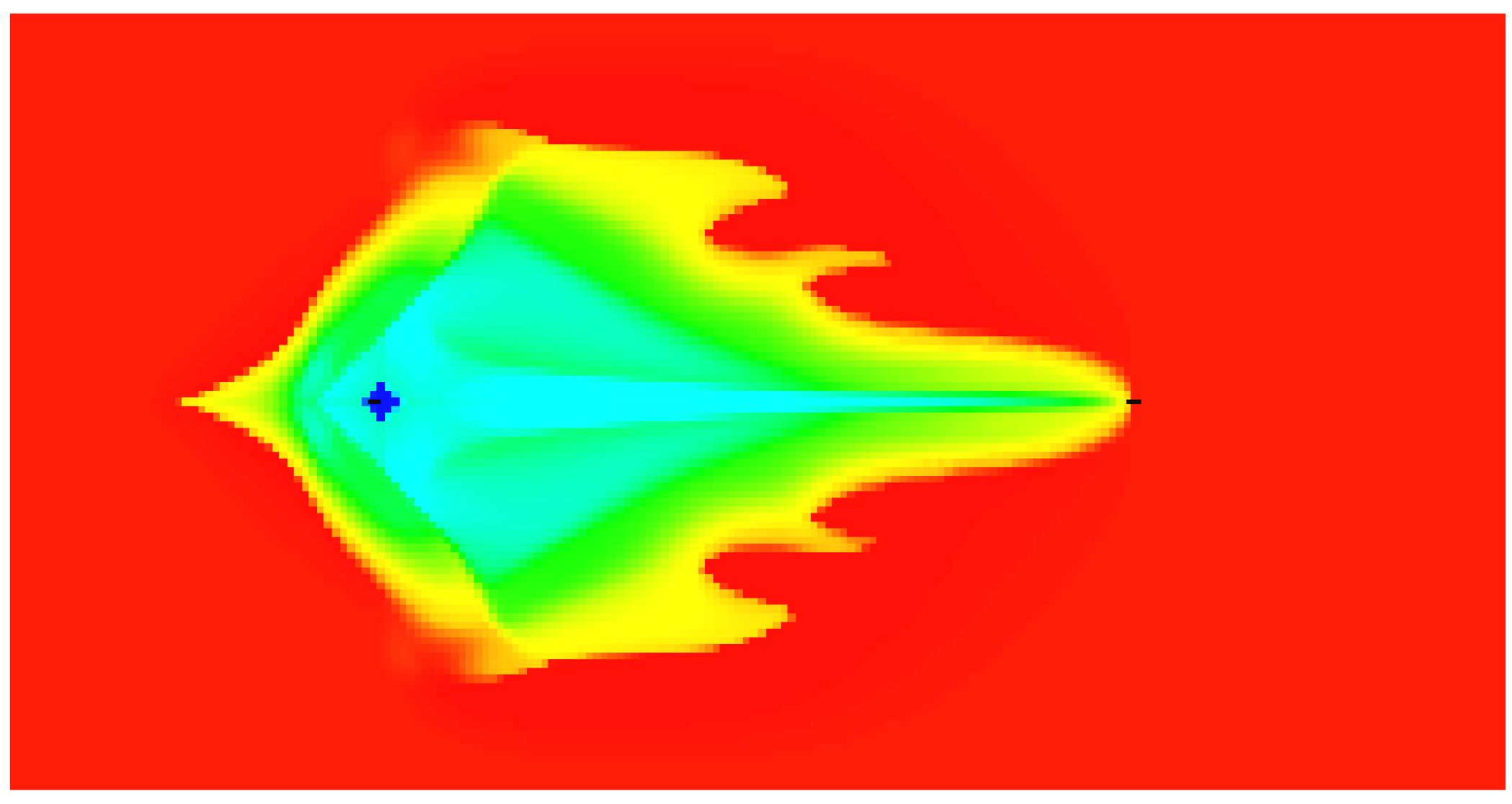

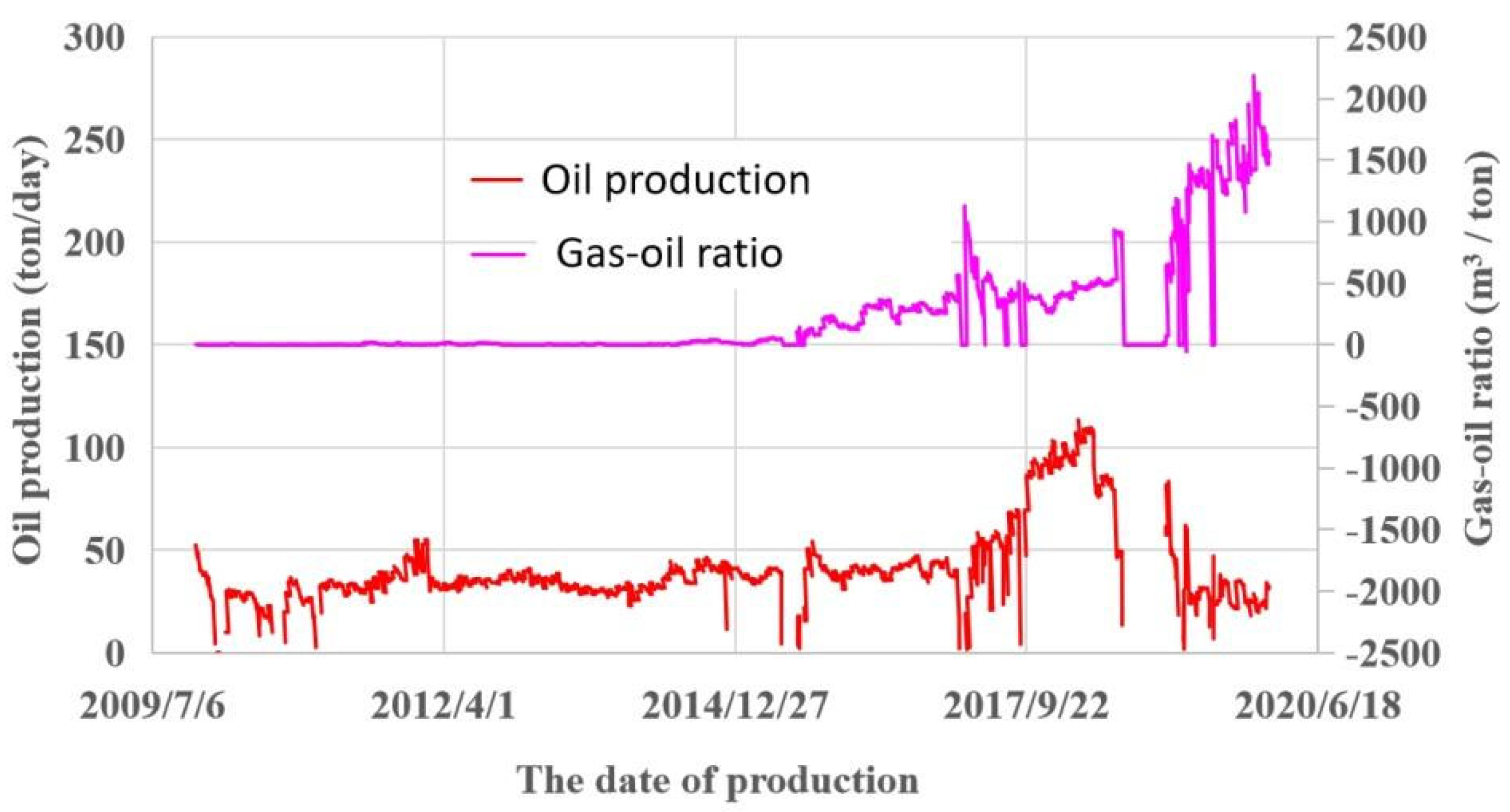
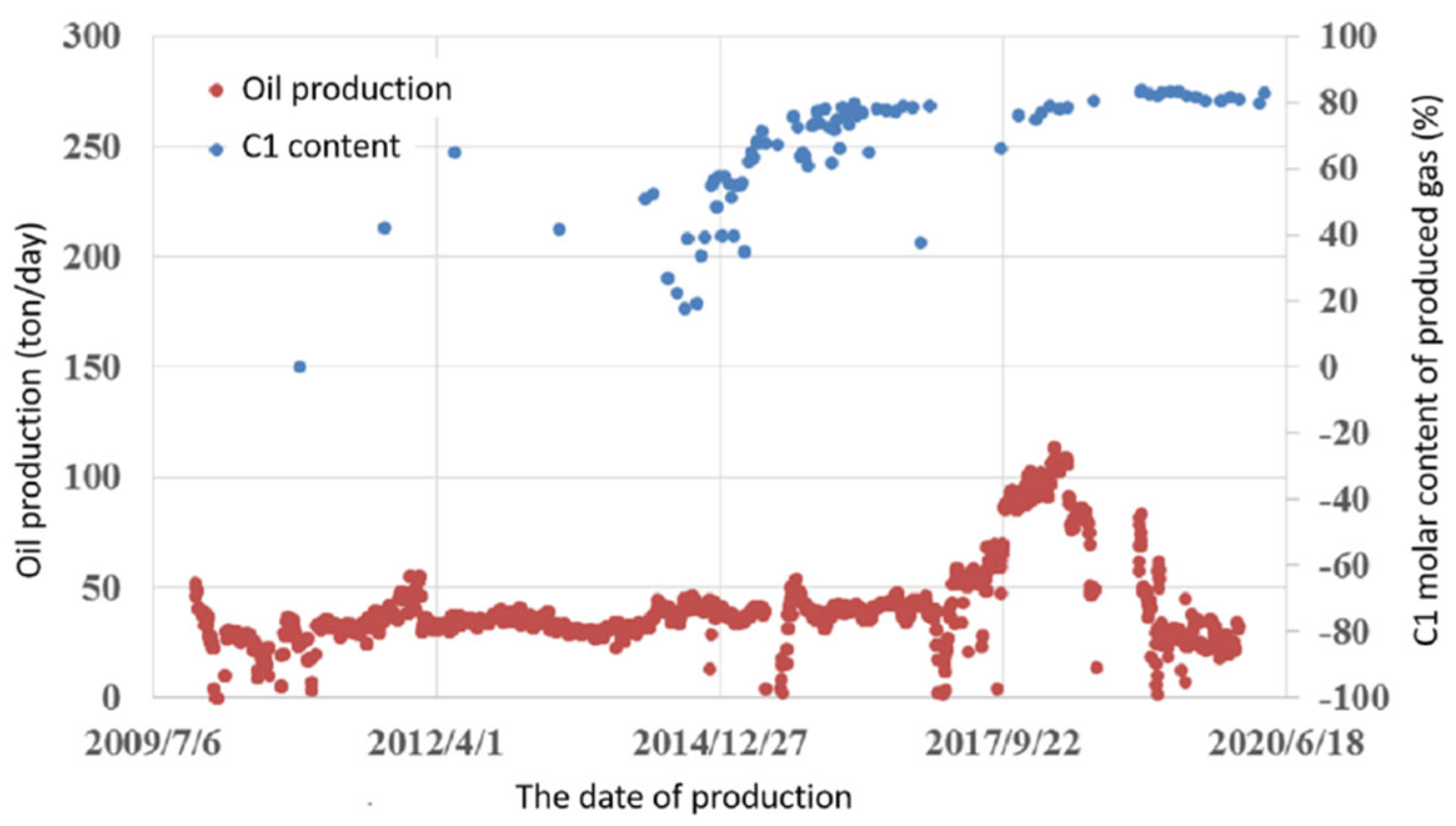
| Parameter | Value |
|---|---|
| Model size (m) | 800 × 400 × 100 |
| Grid system (x × y × z) | 51 × 31 × 119 |
| Porosity (%) | 15 |
| Permeability (mD) | According to the permeability (30–80 md) of a well in this area, and considering the heterogeneity in X, Y, and Z directions |
| Injection-production well spacing | One injection and one pick |
| Injection-production well spacing (m) | 400 |
| High-Pressure Physical Property | Measured Value | Software Calculated Value | Error (%) |
|---|---|---|---|
| Saturation pressure (MPa) | 6.072 | 6.045 | −0.44 |
| Single degassing oil ratio (m3/m3) | 15.1 | 15.13 | 0.20 |
| Underground crude oil density (g/cm3) | 0.7989 | 0.799 | 0.01 |
| Degassed crude oil density (g/cm3) | 0.8515 | 0.8233 | −3.31 |
| Serial Number | Production Phase Zone | Characteristics of Production Indicators | ||
|---|---|---|---|---|
| Oil Production | Gas Oil Ratio | C1 Content of Produced Gas | ||
| 1 | Original oil phase | Continued decline, later may be slightly increased | The original gas-oil ratio is low, about dozens | Basic constant |
| 2 | Mixed zone (dissolved gas-oil zone + miscible zone + front edge of two-phase zone) | It rises rapidly at the beginning, reaches the highest level for a period of time, and then declines rapidly | Early rapid rise, midway steady rise, and rapid rise later | It rises sharply in the early stage, slows down in the middle, and forms a relatively stable platform, and rises again in the later stage |
| 3 | Two-phase band trailing edge | Continued to decline | Continue to rise | Continue to rise slowly from a high plateau |
| Serial Number | Formation Pressure | Miscible Degree Pave/MM% (Miscible Pressure 43.24 MPa) | Gas Channeling Judgment Eigenvalue |
|---|---|---|---|
| 1 | P > 50 MPa | >1.23 | gas-oil ratio 1650, C1 Content 82.5% |
| 2 | 47 MPa < P ≤ 50 MPa | 1.09–1.23 | gas-oil ratio 1450, C1 Content 82.5% |
| 3 | P < 47 MPa | <1.09 | gas-oil ratio 1800, C1 Content 83.3% |
Publisher’s Note: MDPI stays neutral with regard to jurisdictional claims in published maps and institutional affiliations. |
© 2022 by the authors. Licensee MDPI, Basel, Switzerland. This article is an open access article distributed under the terms and conditions of the Creative Commons Attribution (CC BY) license (https://creativecommons.org/licenses/by/4.0/).
Share and Cite
Luo, J.; Wang, L. Research on Gas Channeling Identification Method for Gas Injection Development in High-Pressure Heterogeneous Reservoir. Processes 2022, 10, 2366. https://doi.org/10.3390/pr10112366
Luo J, Wang L. Research on Gas Channeling Identification Method for Gas Injection Development in High-Pressure Heterogeneous Reservoir. Processes. 2022; 10(11):2366. https://doi.org/10.3390/pr10112366
Chicago/Turabian StyleLuo, Juan, and Lei Wang. 2022. "Research on Gas Channeling Identification Method for Gas Injection Development in High-Pressure Heterogeneous Reservoir" Processes 10, no. 11: 2366. https://doi.org/10.3390/pr10112366
APA StyleLuo, J., & Wang, L. (2022). Research on Gas Channeling Identification Method for Gas Injection Development in High-Pressure Heterogeneous Reservoir. Processes, 10(11), 2366. https://doi.org/10.3390/pr10112366









